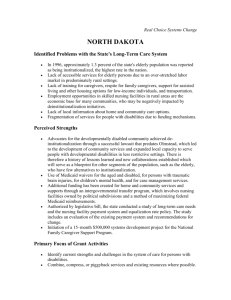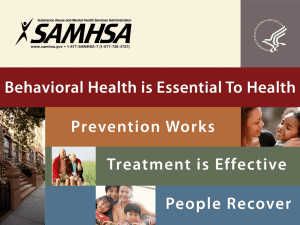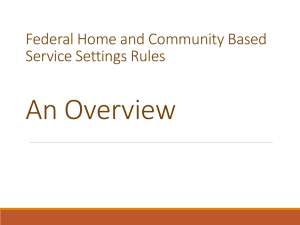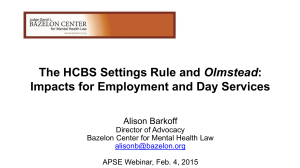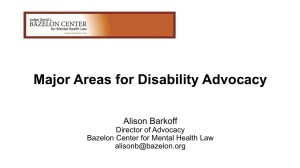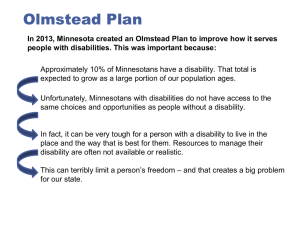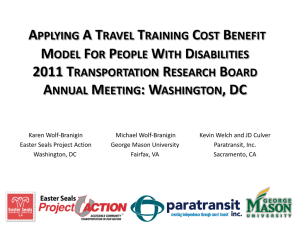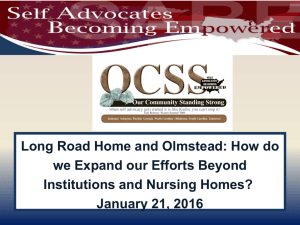Supportive Housing Powerpoint - National Association for Rights
advertisement
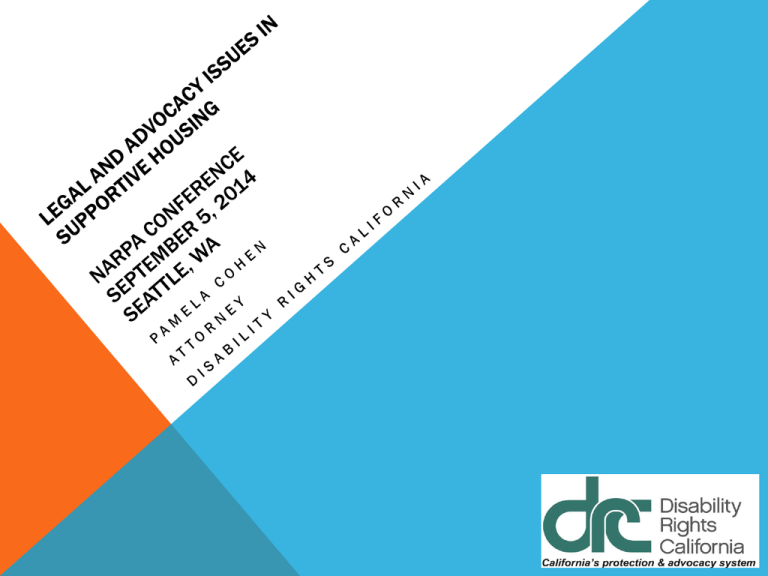
OVERVIEW - Supportive Housing: What & Why? Supportive Housing Advocacy - ADA Integration Mandate - Fair Housing Laws - Land Use and Planning - Siting Strategies SUPPORTIVE HOUSING: WHAT AND WHY? WHAT IS SUPPORTIVE HOUSING? -Permanent: No time limits -Supported: Flexible non-mandated onsite or offsite services and supports to maximize independence -Rights and responsibilities of tenancy -Affordable -Integrated -Choice of units and roommate NEW HCBS MEDICAID RULE All Settings Eligible for HCBS Waiver Reimbursement Must: - Be integrated in and support full access to the community; - Be selected by individual from among options; - Ensure rights to privacy, dignity, respect and freedom from coercion and restraint; - Optimize autonomy and independence in making life choices; and - Facilitate choice regarding services and providers NEW MEDICAID HCBS RULE Additional Criteria for Provider-Owned or Controlled Home and Community-Based Residential Settings: - Individual has lease or similar agreement; - Individual has privacy in unit including lockable doors, choice or roommates and freedom to furnish or decorate the unit; - Individual controls his or her own schedule including access to food at any time; and - Setting is physically accessible . NEW MEDICAID HCBS RULE Rebuttable presumption that these are NOT communitybased settings: - Nursing Facilities - Institutions for Mental Disease - Intermediate Care Facilities for People - Hospitals - Any other setting that has the effect of discouraging integration of individuals from the broader community SUPPORTIVE HOUSING WORKS SH is a successful, cost-effective model for providing housing & services to people who would otherwise be institutionalized or at risk of institutionalization. - National Governors Association; NASMHPD; DOJ; HUD; Surgeon General; SAMHSA; National Council on Disability SUPPORTIVE HOUSING ADVOCACY - ADA Integration Mandate - Fair Housing Laws - Land Use and Planning Laws - Siting Strategies ADA INTEGRATION MANDATE ADA INTEGRATION MANDATE States must “administer services, programs, and activities in the most integrated setting appropriate to the needs of qualified individuals with disabilities.” 28 C.F.R. § 35.130(d) 28 C.F.R. § 41.51(d) UNNECESSARY INSTITUTIONALIZATION: - Perpetuates unwarranted assumptions that people with disabilities are incapable or unworthy of participating in community life; and - Severely diminishes everyday life activities, including family relations, social contacts, work options, economic independence, educational advancement, and cultural enrichment. Olmstead v. LC, 527 U.S. 581 (1999) COMMUNITY PLACEMENT REQUIRED WHEN: 1. The state’s treatment professionals have determined that community placement is appropriate; 2. The individual does not oppose community placement; and 3. The placement can be reasonably accommodated, taking into account the resources available and the needs of others with disabilities. Olmstead v. LC, 527 U.S. 581 (1999) OLMSTEAD PLANS A state can establish a fundamental alteration defense through a comprehensive, effectively working plan for community placement, and a waiting list that moves at a reasonable pace not controlled by endeavors to keep institutions fully populated. SUPPORTIVE HOUSING AS OLMSTEAD REMEDY Remedies for Olmstead violations “typically require the public entities to expand the capacity of community-based alternatives by a specific amount, over a set period of time.” - Statement of the DOJ on Enforcement of the Integration Mandate of Title II of the ADA and Olmstead v. L.C. (Jan. 22, 2011) CONSUMER CHOICE “Individuals who have been institutionalized and segregated have often been repeatedly told that they are not capable of successful community living and have been given very little information, if any, about how they could successfully live in integrated settings. As a result, individuals’ and their families’ initial response when offered integrated options may be reluctance or hesitancy.” - Statement of the DOJ on Enforcement of the Integration Mandate of Title II of the ADA and Olmstead v. L.C. (Jan. 22, 2011) CHAMBERS V. SAN FRANCISCO (ND CA 2006) SETTLEMENT (2008) Housing - Preservation of Housing - LHH Rental Subsidy Program Services & Case Management -Access to NF/AH Waiver Services - Diversion and Community Integration Program -Targeted Case Management - Community Living Plans - City-Funded Community Living Fund - City-Provided MH & SA Services O’TOOLE (DAI) V. CUOMO (ED NY 2003) SETTLEMENT (2013) NY state will provide as many scattered-site, supported housing units as necessary to afford all adult home residents with serious mental illnesses the opportunity to live in the most integrated setting appropriate to their needs, and will provide and maintain community services and supports. O’TOOLE (DAI) V. CUOMO (ED NY 2003) 2013 SETTLEMENT Community services and supports include, but are not limited to: - Care coordination - Psychiatric rehabilitation services - Employment services - Assistance with taking medication - Home health care - Personal assistance services - Assertive community treatment - Crisis services - Hundreds of thousands of people with disabilities remain on waiting lists for HCBS services. - People younger than 65 are increasingly being isolated in nursing homes; - Progress in providing HCBS for persons with physical disabilities and mental illnesses has lagged significantly behind efforts for individuals with intellectual and developmental disabilities. U.S. Senate “Harkin Report,” Separate and Unequal: States Fail to Fulfill the Community Living Promise of the Americans with Disabilities Act (July 18, 2013) FAIR HOUSING LAWS CONSTITUTIONAL DUE PROCESS - Land use and zoning ordinances violate 14th Am right to due process if they are not rationally related to a legitimate governmental purpose City of Cleburne v. Cleburne Living Center, Inc 473 U.S. 432, 446 (1985) - State constitutions may provide more protection. FAIR HOUSING STATUTES - Fair Housing Amendments Act (1988) Americans with Disabilities Act (1990) Section 504 Rehabilitation Act (1973) Similar State Statutes FAIR HOUSING AMENDMENTS ACT Unlawful to “discriminate in the sale or rental, or to otherwise make unavailable or deny, a dwelling to any buyer or renter because of a handicap of that buyer or renter, a person residing or intending to reside in that dwelling after it is sold, rented or made available, or any person associated with that buyer or renter.” 42 U.S.C § 3604(f)(1) USING FAIR HOUSING LAWS TO PROMOTE SH Discriminatory Actions Directly by Neighbors - Intimidation, Threats, Harassment & Coercion - Free speech concerns - Neighbor Buy-Outs - “Normal economic competition” USING FAIR HOUSING LAWS TO PROMOTE SH Discriminatory Actions by Local Government - Siting Barriers - Numerical Restrictions - Spatial Separation Restrictions - Pretextual Health and Safety Restrictions - Refusal to Fund - Refusal to cooperate with funding application LAND USE AND PLANNING LAWS FEDERAL AND STATE PLANNING REQUIREMENTS -Consolidated Plan - Condition of federal funding for affordable housing - Similar State Law Requirements - E.g. California Housing Elements ELEMENTS OF CONSOLIDATED PLANS Con Plans Must Include: - Housing and Homelessness Needs Assessment - Market Analysis - Strategic Plan - Annual Action Plan - Summary of Citizen Participation and Consultation - Annual Certifications of Compliance Any housing activities supported by federal funds must be consistent with the jurisdiction’s Con Plan. USING LAND USE PLANNING TO PROMOTE SH - Participate in planning processes at federal, state and local levels - Nothing about us without us - Ensure that land use plans comply with fair housing laws - Reasonable accommodation ordinances - Ensure that proposed or existing restrictive zoning ordinances comply with land use plans - Local officials consult zoning codes, not planning documents SITING STRATEGIES SIX STEPS TO BUILDING COMMUNITY SUPPORT 1. Plan at least two meetings to research, assess and plan strategies in key areas. 2. Prepare a political strategy. 3. Prepare a strategy to build public support. 4. Prepare a strategy to work through community issues. 5. Prepare a legal strategy. 6. Prepare a public relations/media strategy. QUESTIONS? HELPFUL WEBSITES – US GOVERNMENT - Center for Medicare and Medicaid Services: www.medicaid.gov - Department of Housing and Urban Development: www.hud.gov - Department of Justice: www.justice.gov - Substance Abuse and MH Services Administration: www.samhsa.gov HELPFUL WEBSITES – NONPROFITS - - - Bazelon Center for Mental Health Law: www.bazelon.org Corporation for Supportive Housing: www.csh.org Disability Rights California (coming soon: Everyone’s Backyard – Addressing “Not In My Backyard” Opposition to Supportive Housing for People with Mental Health Disabilities) www.disabilityrightsca.org Technical Assistance Collaborative: www.tacinc.org CONTACT INFORMATION Pamela Cohen Disability Rights California 1330 Broadway, Suite 500 Oakland CA 95616 (510) 267-1200 Pamela.cohen@disabilityrightsca.org
